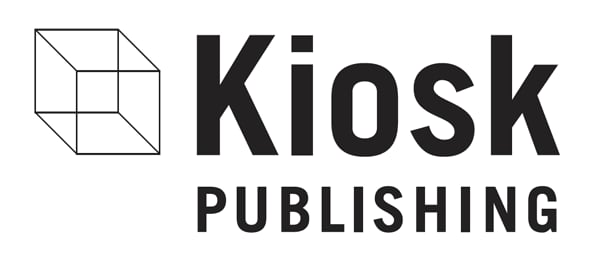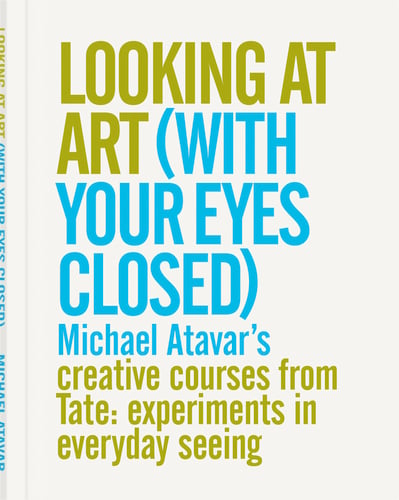
Looking At Art (With Your Eyes Closed)
2019
Includes 52 exercises for your next visit to the modern art museum.
ISBN-13: 978-0953107353
Paperback: 128 pages
Size: 148mm X 115mm
Shrink-wrap
Introduction
This book is about the power of art. The room, the art gallery, only has four walls but it can expand, through your perceptions, to contain much more. Perhaps it can be everything? My volume confers value on you, the viewer, the potential artist. It makes you, for the moment of looking, the centre of things. It encourages you to trust your own intuition. Step into a new version of reality. In my own history, the gallery has been an important place, an area of discovery, of experiment. When I couldn’t access these ideas in real life, the exhibition space gave me the opportunity to take a chance, to play. And so allowed me to explore the boundaries of myself – through visual image, philosophy, new experiences, shock. I became the artist by being there. Therefore, I offer this book to you with a full heart, knowing the impact that art has had on me. I trust that it can have the same effect on you. Look, see, feel.Contents
INTRODUCTION FOREWORD What's The Feeling? / It's The Totality Of The Experience That Counts / Trust Your First Impressions / Be Pretentious / Spend 30 Minutes In Each Room / Sit Down (If Necessary On The Floor) / Close Your Eyes / As Things Pop Up, Write Them Down / Use Your Own Voice / Give It Another Name / What Is Un-Say-Able / Use The 'I' Word / Liquidity / Detune Your Eyes / Put Yourself In The Frame / Take A Step Forward / Slow Down / Draw It / Turn It Upside Down / Or Turn Yourself Upside Down / Make A Map / Change Figurative To Abstract / Get Your Hands Dirty / Don't Read The Label Or Listen To The Guide / Don't Take Photographs / Make a List Of Qualities / Choose Something That Repels / Imagine What You Are Looking At Doesn't Exist / Use The Gallery And Its Double / Climb Down The Ladder / Become The Main Event / Mirror Yourself / Cave Painting / Describe It In One Word / Visit A Single Item / Start At The End And Work Backwards / Zoom Out / Ask A Child's Opinion / Use Your Curiosity / Be Authentic / Step Inside The Image / Leave The Room And Come Back / Be Prepared To Exit / Take Away 90% Of The Image / Shrink It / Ask A Stranger What They Think / Yesterday, Today, Tomorrow / Leave The Gallery / Aftermath / You, The Artist / The Wound / Endings EPILOGUE – USING MENTAL TECHNIQUESSample
WHAT’S THE FEELING? You are in the gallery and the work is in front of you. How do you proceed? At this moment it’s worth remembering that it’s the feeling that the piece evokes in you that's important. Nothing else matters. Of course, there is content, form, colour – but put that aside just now. What does the painting or sculpture provoke in you? Don’t confuse a thought for a feeling; don’t allow an intellectual process to take the place of an emotion. If you start with – • The artist intends • Historically • A formal conceit • Their colour palette then you are on the wrong track. Instead, start with ‘I’. ‘I feel’, ‘I understand’, ‘I believe’. Make yourself the subject. The artwork is merely a vehicle to get you to the best version of yourself.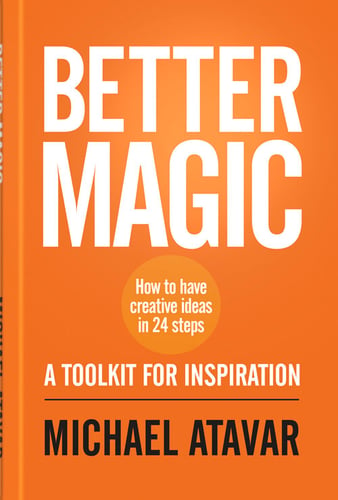
Better Magic
2016
Uses your unique creativity to deliver new and inspiring ideas.
ISBN-13: 978-0953107346
Paperback: 256 pages
Size: 180mm X 120mm
Shrink-wrap
Introduction
This is a book that offers you some techniques for generating ideas. However, rather than describing brainstorming processes that already exist, I look to the unconscious as a source of inspiration. You already carry this unconscious material with you, all the time, as a repository, a library of information inside yourself. The trick is to use your awareness in order to make it manifest. From paper, to objects, to process – my book details a series of exercises that you can use to build a relationship with this unconscious element. To assist me, I call on the influences of art, psychology, experimental writing, anthropology and concrete poetry. Always with the intention of waking you up, overturning conventional processes and finding the best, most innovative ideas. It’s a journey to the self. Take a deep breath.Contents
WORKING WITH PAPER Write It Down / Read Down The Page / Words Are Clues / Employ Ambiguity / Integrate Mistakes / Find Ideas In Unexpected Places / Use Cut-Ups / Magnetise Audacity / Cutting Room Floor Technique / Experimental Conditions Persist / The Fold / Invite Nonsense / The Noigandres / Try Word Games / Start In The Wrong Place / Enduction WORKING WITH OBJECTS Use Your Hands / Follow The Street / Paper Plane / Chinese Tiles / Be Physical / Sixty Seconds / No Accidents / Provoke Bad Ideas / Remember The Anonymous / Integrate The Reverse / Inverted Constable / Printing Upside Down / Work Backwards / Rename Things / Enduction WORKING WITH PROCESS Apply Your Instinct / Find Double Meanings / Latoa / Make A Pack Of Cards / Shuffle The Group / Create Conflict / Integrate Feelings / Water And Sand / Trust What You Can’t See / Fringes Of Perception / Evoke Dream Analysis / Use Magic / Appurtenances / Better Magic / Enduction NOTES ON THE CREATIVE UNCONSCIOUSSample
As you read the book, write your ideas down. It seems obvious. However, in most cases, people don’t do this, so the concepts escape. They can’t remember the exact version of words that made their thoughts so unique. Ideas have a fleeting life. Writing concretises them on the page, makes them real. It gives them substance. If you don’t download from your brain to the page your ideas on a regular basis, you clog up your mind with old thoughts, now past their sell-by date and therefore don’t create a space for new ideas to come through. So buy a cheap notepad and pen and write all your ideas down. Every time you have a thought about creativity, your business, products or the client – make a note of it. Even if you work visually, still write your ideas down. If the blank page looks empty and frightening, start at the end of your notepad and work backwards, as if you are filling in void spaces, like colouring in a drawing in a child’s picture book. Each day complete only a single sheet of paper. Stalk your big idea slowly. When the notepad is full, your project will be complete.
Everyone Is Creative
2013
Focuses on the power of creativity and how it can transform your life.
ISBN-13: 978-0953107339
Paperback: 256 pages
Size: 180mm X 120mm
Shrink-wrap
Introduction
What do we need to be creative? Actually we already have the tools within us; we carry them with us every day – our eyes. All that‘s required is that we see, use our vision and accurately record the world around us. Nothing more is needed. This book offers some suggestions for developing your ability to see – where to place emphasis, what to look at, where to start. Always encouraging you to develop your ‘unique eye’, a vision of the world that I believe you already innately possess. Everyone is creative. Everyone is creative, whether they admit it or not, whether they accept it or not. So try being an ‘artist’, embrace the ‘A’ word. Look around – what is happening right now in front of you? Try it. What have you got to lose? Everyone Is Creative is the third in Michael Atavar’s series of books about creativity, following on from How To Be An Artist and 12 Rules Of Creativity.Contents
ONE IDEA On Your Own / Basics / Rucksack / Leave The Stage Empty MATERIALS I Start With Materials / If You Think... / Sensuality & Surface / Use You / Emergence & Risk / Factory Blue / Foggy Landscape ARTIST'S STATEMENT I Believe / A Piece Of Fiction / Fireworks / Write In Reverse / Chop Wood MANIFESTO You Are Not Alone / Anti-You / This Page Is Left Blank / Draw Blood THINK SMALL 100-1% / Playing Scales / Blurred Pictures / Offending The Audience UNIQUE EYE One Book / Nothing To Say (I Don’t Believe You) / X-Rays / Poor Art / Write It Down / I’m Drawn To Ideas X, Y, Z SEEING Taboo Against Looking / What Do I See? / Use Whatever Is Already There IMAGES An Opening Into You / Draw Approximations / The Desert / Wild Horses On The Wall / Found Material / Le ‘C’ Dream / The Reverse I SEE A Glass On A Table / Rods / I See A Palm Tree / Long Stories / Laser Cone / Ishihara EVERYONE IS CREATIVE Art Is... / Rhododendrons / Dirty Water / The Fountain / Close Your EyesSample
Art is easy... However, being an artist is more difficult. It requires discipline, bravery, originality and perseverance. (None of these are easily won.) To accomplish these goals, focus on your day-to-day creativity, rather than attempting to make ‘Art’ with a capital ‘A’. If you follow this modest path of everyday achievement, you won’t go far wrong. Forget all sorts of fixation with creating products; it won’t help you. Instead, invest in a daily process as the mainstay of your practice. Look at things – even if this first appears difficult. Keep your eyes open all your life; look at shapes, faces, colours, lights. Even if there’s ‘nothing there’, even if there’s a brick wall, or grey clouds, there is always something worth looking at. Trust your ‘unique eye’, your original seeing of the world. It’s the basis of all art and the centre of your creativity. Your world is unique, intrinsic to you.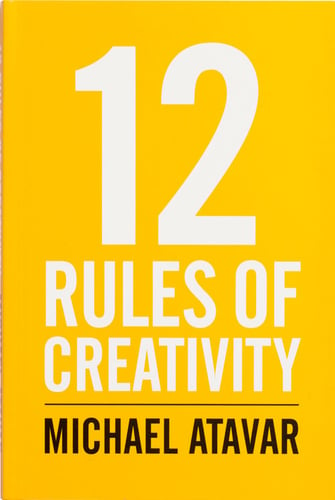
12 Rules Of Creativity
2011
Contains twelve practical steps that help to stimulate your creativity.
ISBN-13: 978-0953107322
Paperback: 272 pages
Size: 180mm X 120mm
Shrink-wrap
Introduction
12 Rules Of Creativity is a book of twelve practical steps that help to stimulate your creativity. Michael Atavar guides you through the basic principles of the creative process – how to begin, developing an original voice and working with creative blocks. From beginner to famous artist, everyone at some time in their career will become stuck. These twelve rules will help you to navigate the stages of impasse, freeing up the log-jam of ideas. Packed with tips and insider information, the book represents a useful repository of original ways of thinking – methods that can be applied to any area of creativity. If you take one thing away from the reading of this book, it should be that creativity, as it manifests within you, is always possible. 12 Rules Of Creativity is the follow-up to Michael Atavar’s best-selling How To Be An Artist.Contents
RULE 1 No Lightning Flash / Marks / Today My Eyes See RULE 2 The Automatic / Basic Materials RULE 3 Tuning In / Tent / Interview Yourself RULE 4 Is That Me? / Lasso RULE 5 Switch Places / Listening Space / Working With Shadows / Being Here / What’s At The End Of Five RULE 6 Magnify The Negative / Reduce Your Options / Confucius Says / A4 RULE 7 Be A Receiver / Brick Wall / Leaps In The Mind / 24 Hours RULE 8 Use Colour RULE 9 Boredom / Change Your Name / Become Invisible RULE 10 2CG / From The Floor / Cut-Up RULE 11 Microphony / Left Hand / Tokyo Subway RULE 12 Call Out My Name / 16 / Tuning Out / Sleep / 12 Rules Of CreativitySample
Open your eyes. What can you see? Carry a notepad and pen with you at all times and use it to write about what’s around you – words, illustrations, sentences. Because they come from you, these observations will necessarily be individual, unique. Every pair of eyes is tuned to an original way of seeing. Each pair of ears hears different things. The things that you might write in your notepad are – • The colour of cars. • Descriptions of faces on the train. • Snatches of conversation. • Sunlight. • Abandoned furniture. • LED displays. • The beeps of mobile phones. • Sunsets. Don’t let some elevated idea of what creativity might be dissuade you from recording what you see every day. Allow yourself to develop a practice of just looking.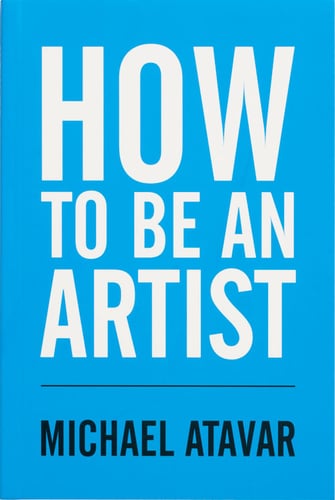
How To Be An Artist
2009
Develops your creativity and grows the potential of your own artist.
ISBN-13: 978-0953107315
Paperback: 256 pages
Size: 180mm X 120mm
Shrink-wrap
Introduction
This is a book about how to develop your creativity. If you want to tap into that unexplored part of yourself that gets bulldozed by work, commitments, lack of space, then this is the book for you. I believe that you can grow your artist in a nurturing and supportive way, giving it the time and resources to develop and blossom. This is a book that takes the inner artist seriously – the playful, the complicated, the difficult part – leading it on a journey that includes starting, building a practice and planning long term goals. If you are an experienced practitioner, there is also much to discover in this book about getting in touch again with the key ideals that drew you to creativity in the first place. For everyone, I suggest reading the book from page one onwards, or alternatively dipping into it, using your artist’s compass to recognise that wherever you begin, and on whatever page, wherever you find yourself, is exactly the right place for you.Contents
PART 1 HOW TO START Simple methods for overcoming the fear of beginning. Blank Paper / How To Start / Pen, Notepad, Eye / Sort It Out Later / Be Seen / Simplicity / Amplification / Mood Board / It Doesn’t Have To Be Perfect Now / ABBA / Dotted Line Technique / One Sentence / One Long Line / Working With Limitations / Voices Of Criticism PART 2 DEVELOPING A PRACTICE Building an artist’s vocabulary that’s distinctively your own. Invitation To Process / No Magical Manager / Developing A Vocabulary / Artist’s Compass / No boundaries / Scraps / Tell Us How It Feels / Ideas For Cash / Grow Your Own Artist / Curiosity / What’s Inside You / Time / Doing Nothing / Titles / Slogans / The Flower Is Red / The Child Part / Give Them Something For Free PART 3 WORKING ON YOURSELF Intuition and feedback as the basis for your ongoing process. Value Yourself / Work For Free / Parent And Child / Generosity / Go Where The Energy Is / The Us And Them Wall / A Day Without Money / Why Do You Do It? / Intuition / Feedback / Draw Your Day / How To EndSample
Blank Paper The piece of paper is in front of you. You might feel afraid. But courage, my friend. Pick up a pen and without thinking begin to write. It’s not important what it is, or what you say, simply write. Within this automatism, these endless words, you will begin to see sentences and structures form. Perhaps they don’t mean anything yet, but that’s OK. You have got over the first hurdle – the emptiness of the white page. That’s the good news. The bad news is that you will always meet this feeling. It’s part of being an artist, being creative. Your choice, your journey is to address this sense, each time you start. With practice, and with endless attempts, it will get easier. The page starts to look inviting, open, challenging, even warm. It holds enrapture, magic, possibility. The energy that you feel when beginning to write will carry you forward, beyond the first page, into all your writing. Follow the energy, follow the road, follow the words – let the sentences take you with them.